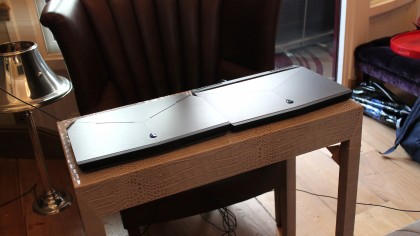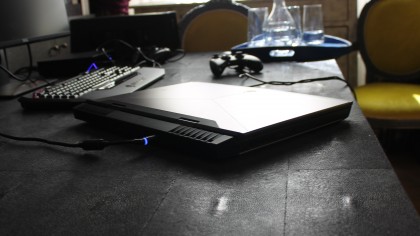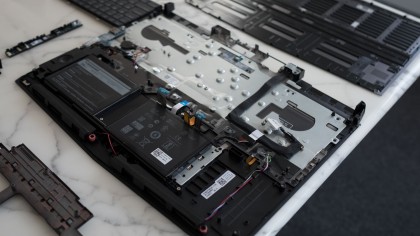Alienware: 'We could make thinner laptops, but we don't feel that benefit right now'
New Pascal-powered 13, 15 and 17 systems focus on performance

Alienware has arrived fashionably late to the Pascal party. The premium PC maker's absence was notable at the recent launch of Nvidia's new GTX 10-powered notebooks, with no new models to be found among the 14 gaming laptops powered by the company's new GPU architecture.
Some weeks later, Alienware has now unveiled revamped versions of its Alienware 13, 15 and 17 systems. Arguably revolutionary on the inside thanks to their GTX 1060, 1070 and 1080 graphics parts, they also feature evolutionary designs and compatibility with the upgrade-focused Alienware Graphics Amplifier.
TechRadar sat down with the Frank Azor, General Manager of Alienware and XPS, to get the detail on the company's new trio of systems.

TechRadar: Alienware has resisted the urge to go too thin with these new laptops. Is that because you feel there's a balance to be made between portability and performance where the notebook form factor is concerned?
Frank Azor: There's many reasons for that. We could always make them a lot thinner at the compromise of certain features and benefits, but we don't feel that benefit right now in this category of product.
What are the benefits of having a thicker chassis?
One reason is the quality of the materials that we can use - from the aluminum, magnesium-alloy and carbon-fibre materials in there to the copper heatsinks and steel-reinforced keyboards. The battery packs we put in our notebooks offer the longest battery life for any gaming laptops out there - they are the heaviest components in the entire systems. We're putting ninety-five watt-hour batteries in our existing notebooks, and ninety-nine watt-hour ones in our next-generation models. The battery pack probably weighs like a pound-and-a-half by itself.
Sign up for breaking news, reviews, opinion, top tech deals, and more.

So it's about sacrificing portability for increased performance?
Again, it's just a different design philosophy - we're designing for the gamer that wants no compromises. That's who we appeal to and what is expected from Alienware, and it all comes in a certain form factor, size and weight. Some other folks have different goals in mind - they're looking to design something that's really thin and light for customers who might not be as interested in future expandability and want to compromise some performance or upgradability in exchange for a form factor.

Only the 17-inch model can be configured with a GTX 1080. How come it isn't available in the Alienware 15?
A 1080 mobile card has a significantly larger footprint and thermal output than the 1070 that's in the new Alienware 15, which is significantly thinner than the existing one. The 1070 GPU is replacing what was previously referred to as the 980M, and the 1080 is a replacement for the 980 desktop chip. Putting a 1080 in the Alienware 15 would've been unappealing as it would almost have made it into a 17-inch form factor. We reserved the 1080 for a 17-inch platform where we had the X, Y and Z dimensions to fit that chip and cool it efficiently.

What kind of performance issues would you run into if you attempted to squeeze a 1080 into a chassis without sufficient headroom for cooling?
What you may find is that some companies may take the 1080 chip and underclock it, then put it into a product and advertise it as a standard 1080. That's not something we're doing with these notebooks - they operate at the full operating criteria for the CPU and GPU, which is one-hundred-and-fifty watts. If we ever put a lower performing version of any graphics card in our product, we would clearly highlight that with the customer so that they knew upfront.

Plus, Dell has the XPS 15 which to a point caters for those who want a slimmer gaming notebook...
The XPS 15 is one of the most decorated products in the entire industry right now. It has a GTX 960M graphics card, quad-core processor, 16GB of memory, an SSD and a 4K display. However, it isn't upgradeable in any way and you can't upgrade the graphics card to, say, a GTX 1060. Its keyboard is a little thinner than the one on the new Alienware models, and there's no lighting features. It's about offering different designs for different customers based on what they value.

The old Alienware 13 was available with an OLED panel. Is that option available on all of the new notebooks?
It's only available on the new 13-inch model right now. Seventeen-inch OLED panels aren't available yet across the industry. It's not available on the 15- or 17-inch models yet, but not because we don't want it. Our partner Samsung, who we worked with on that panel, is having a hard time keeping up with demand for the 13-inch OLED panel, so right now everything is focused on meeting supply. We called that the '13-inch experiment', and it's proven to be worthwhile. We were the first to put an OLED panel on a gaming laptop, so it was a risk. We're still offering it today and are committed to doing so with our future products.

How much extra will customers have to pay for the OLED panel?
We acknowledged that something cutting edge like an OLED panel is going to be made available in limited supply, and at a bit of a price premium. However, we absorbed that cost premium, and if you look at the way we offer the panel today, it's no more expensive than the standard QHD panels we offered before. We want OLED to be a big success and are managing supply and demand with a reasonable lead time on the existing product - we've even put a bunch of OLED Alienware 13 systems in BestBuy stores and have seen a lot of success there.

We took the risk of adopting the panel tech and hope that the industry will benefit from it in the long term. Somebody had to dive in and deal with the complexities, which we're committed to doing. We now hope that, as we work through these things with our partners and demand continues to improve, we can expand the experiment to other screen sizes.
